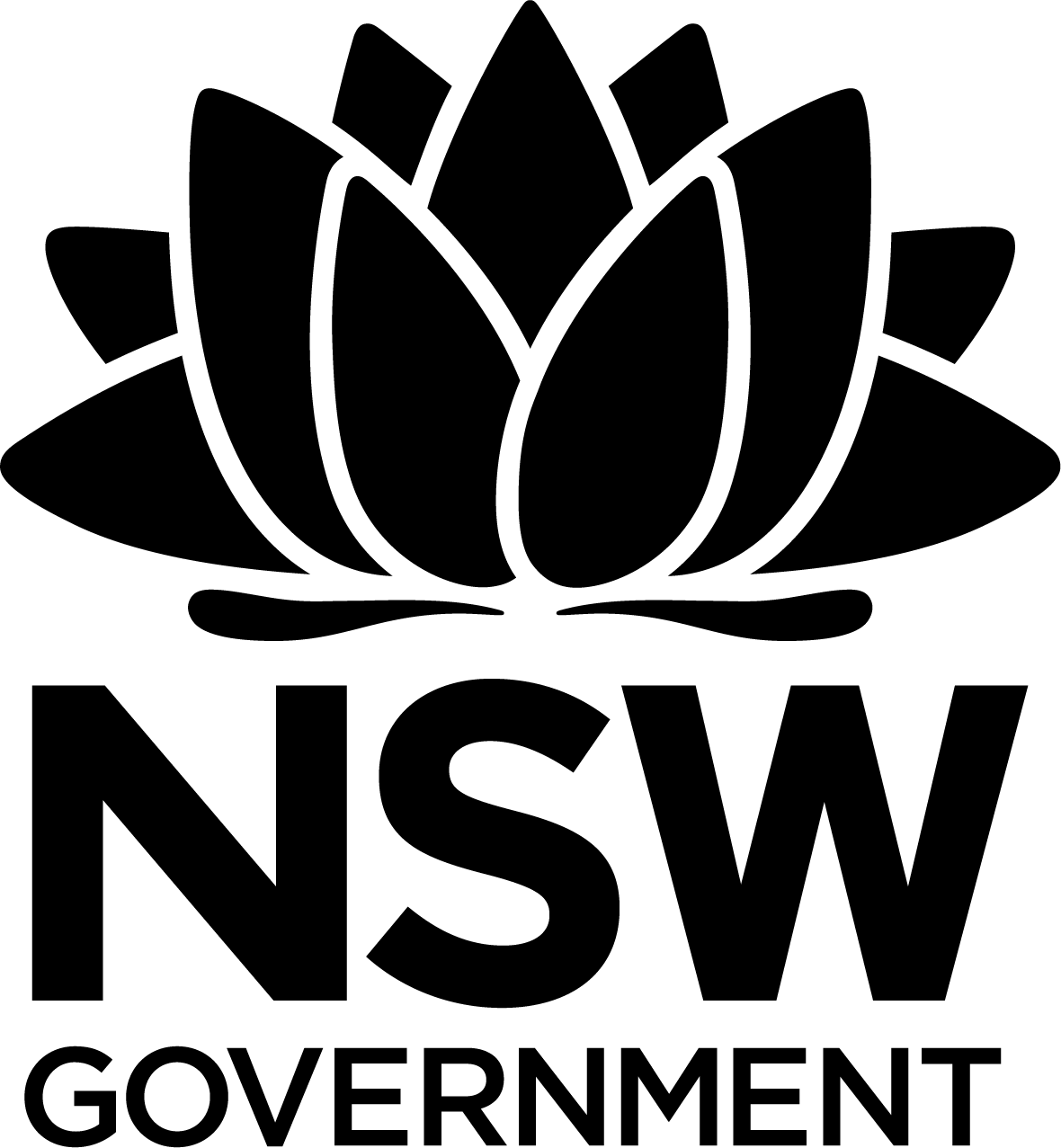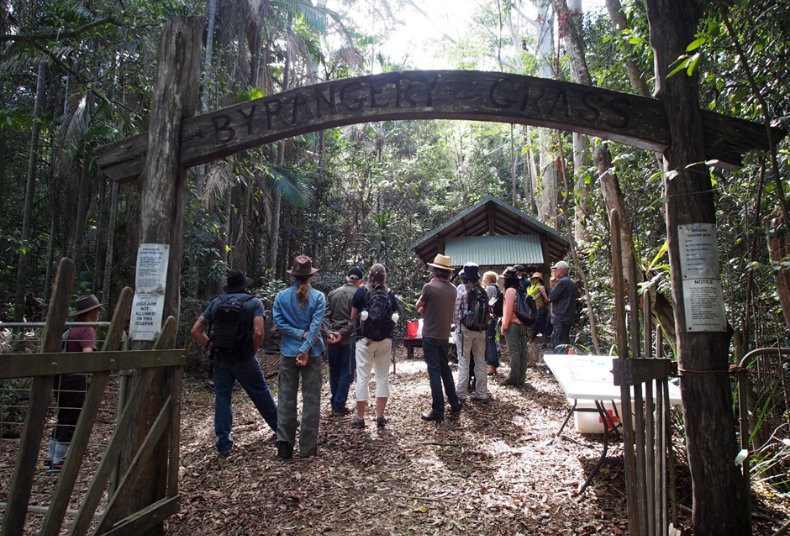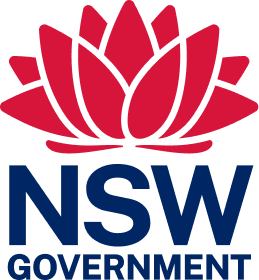
Crown land manager resource
Byrangery Grass Reserve - a natural beauty
19 April, 2023
The Byrangery Grass Reserve straddles a ridge rising over a 15 square hectare of leafy bushland, south of Goonengerry in the Northern Rivers region, and just a short half-hour drive from Byron Bay.
This reserve is designated for environmental protection and is managed by the Byrangery Grass Reserve land manager - a Crown land manager (CLM) volunteer board appointed to care, control, and manage the site.
For over 30 years, volunteers at the reserve have focussed on rehabilitating the site following the simple mission of creating the conditions in which the site can look after itself.

Open day at Byrangery Grass reserve
Grassland site is a true wildlife connector
Visitors to the site can walk along a 1km track that weaves its way past interpretive signs, the ruins of an old drover’s hut, cattle troughs, a well and ancient volcanic vents.
Grant funding has enabled completion of major projects:
- walking track works
- weed control through the Crown Reserves Improvement Fund
- a 10-year Bush Connect rehabilitation grant alongside the Goonengerry and Wilsons Creek Huonbrook Landcare groups, running from 2016 to 2025
- the creation of a “koala safety zone” with road marking and other signage and road sealing works with council support
But the site’s true value comes from its significance to the environment as it acts as a key route, connector, and refuge for flora and fauna, with the CLM (and its predecessors) having overcome threats from mining and mining speculation, livestock use, and invasive woody weeds such as camphor laurel.

Koalas enjoy the “safety zone “on the reserve
Byrangery Grass Reserve & the Big Scrub
The reserve forms an integral part of several remaining patches of “The Big Scrub”, a subtropical lowland rainforest that once spread across eastern Australia but was largely cleared for agriculture.
The reserve’s unique geography creates four different habitat types: grassy woodland, wet and dry sclerophyll forest, and rainforest.
That diversity has created homes for koalas, black cockatoos, Pacific bazas (crested hawks) and major skinks. It also provides resources for migratory birds and several types of bats. There are many endangered and significant plants on the site too, such as the arrowhead vine, the southern quassia and the red bopple nut.
Residents resisted site’s destruction
It was only two generations ago locals faced the very real prospect of the site being mined for its perlite deposits. Degraded by the livestock mustered on the site enroute to the old Byron Bay meatworks, the area was only seen for its rich deposits of the volcanic substance perlite used for construction and horticulture.
In what locals now describe as the 1962 “disaster”, miners scraped a 100-tonne sample along nearly 70m of the ridge line. In 1988, when another company applied to dig for further samples, residents banded together to resist further damage to the site via People for the Environment and Rural Lifestyle (PEARL).
Among the first to get involved was long-time resident Val Hodgson, who worked on the front line as the activists fought for a 1996 mining exemption. Ms Hodgson subsequently joined the Byrangery Grass Reserve Trust which was formed in 1997.
Since then, Ms Hodgson has been among the dedicated volunteers involved in planting natives and killing weeds to transform the site from a weed-strangled landscape to a haven for plants and animals.
Along the way, Ms Hodgson has served as the CLM’s Chair, Treasurer, and remains its Secretary. When she first became involved, the site was neglected apart from the attention of mining speculators, but now as she states, “the area is chock-a-block with endangered species”.
While the reserve is relatively small, Ms Hodgson said it acts as a “point of dispersal” for fauna moving from nearby national parks and from other areas of regeneration on private land. “It has a huge impact for just 15 hectares.”
Volunteers at the heart of the reserve
Ms Hodgson recalled the first meeting of the group, in which “the first thing we did was create a vision statement. And we’ve been working for that vision ever since. It’s all about the reserve becoming self-managing and able to look after itself without help from us.” A great example of that philosophy in practice has been a shift away from planting to weeding and building on those early volunteer efforts with paid professional land managers with skills in bushland regeneration.
The six-member CLM maintains that core vision in its plan for the reserve, which prioritises the following:
- environmental protection, which is also the main purpose of the site
- the conservation of natural resources such as water, soil, flora, fauna, and scenic views
- public use and enjoyment
- multiple uses where appropriate
- sustainable management
- acting in the best interests of NSW, in line with the other principles.
It’s that singularity of purpose and ability to put good governance into practice that saw the Byrangery CLM shortlisted for a Crown land manager excellence award in 2021.

Volunteers maintain connections with the community
The other five Byrangery CLM members are just as dedicated as Ms Hodgson, with most living a stone’s throw from the remnant bushland.
CLM treasurer Alan Goldstein, for instance, has been integral to the organisation’s success in being awarded grants, governing well, and making connections with like-minded groups, such as the Goonengerry Landcare Group, where Mr Goldstein also acts as grants projects manager.
Like Ms Hodgson, Mr Goldstein takes a long-term strategic view when it comes to money, governance, or woody weeds.
Long term vision for funding
The CLM’s fundraising strategy also has a long-term focus. Mr Goldstein said its “secret is that the group doesn’t chase money by making excessive claims about potential impact, but instead ensures any applications match the science and the land manager’s stated mission”.
Environmental grants tend to be highly competitive, and Mr Goldstein said, “the CLM wanted to ensure it put our best foot forward” with the applications it did make, often leaning on the expertise of CLM member and ecologist Sandy Gilmore.
A similar long-term strategic approach applies to the way it works with residents, local councils, indigenous groups such as the Widjabul people, who have a native title claim determination on the reserve , and government departments, which Mr Goldstein said, “comes down to years of relationship building”.

The local council covered the reserve’s costs when sealing a nearby access road and agreed to “koala zone” signs painted on roads.
As Mr Goldstein – an experienced project manager – puts it, “you learn something in the length of a process. There’s no fast track to anything, really. You’ve just got to tick all the boxes.”
The long-term strategic approach is creating a sustainable future for generations to come, the CLM has a vision and a mission to care for the environment far into the future.
More information
About the Byrangery Grass Reserve (booklet, PDF)
Reserve planning: Reserve Manager website
CLM training: NSW Crown Land Passport Program
Crown land 2031 – State Strategic Plan for NSW Crown land

This Crown land manager web resource was printed on 30 Apr 2024. The information contained in this web resource is based on knowledge and understanding at the time of writing Apr 2024. However, because of advances in knowledge, users are reminded of the need to ensure that the information upon which they rely is up to date and to check the currency of the information by referring to the website (www.reservemanager.nsw.gov.au).
© State of New South Wales through Department of Planning, Industry & Environment 2024.
Page link: https://reservemanager.crownland.nsw.gov.au/news-and-events/profiles/byrangery-grass-reserve-a-natural-beauty

